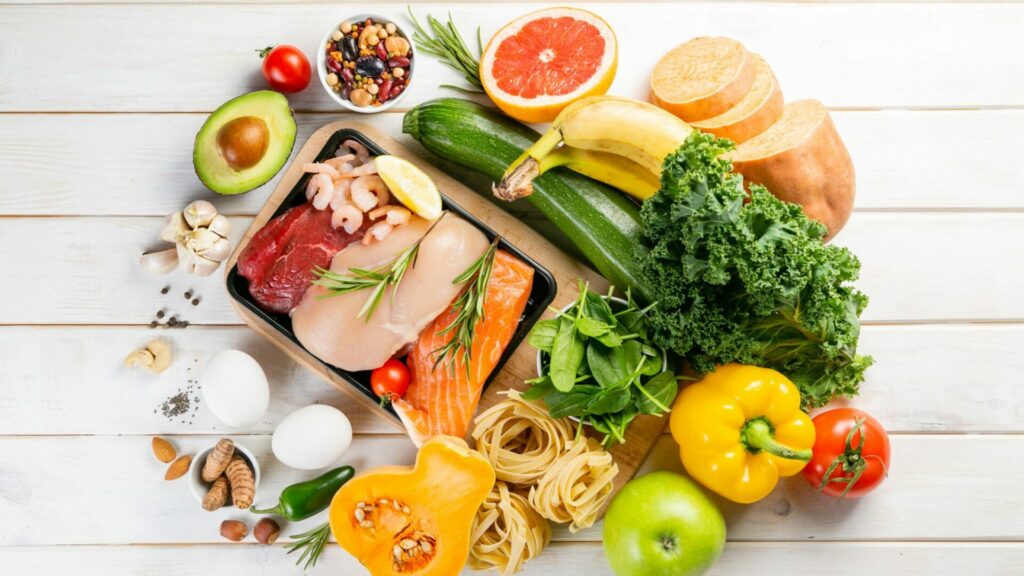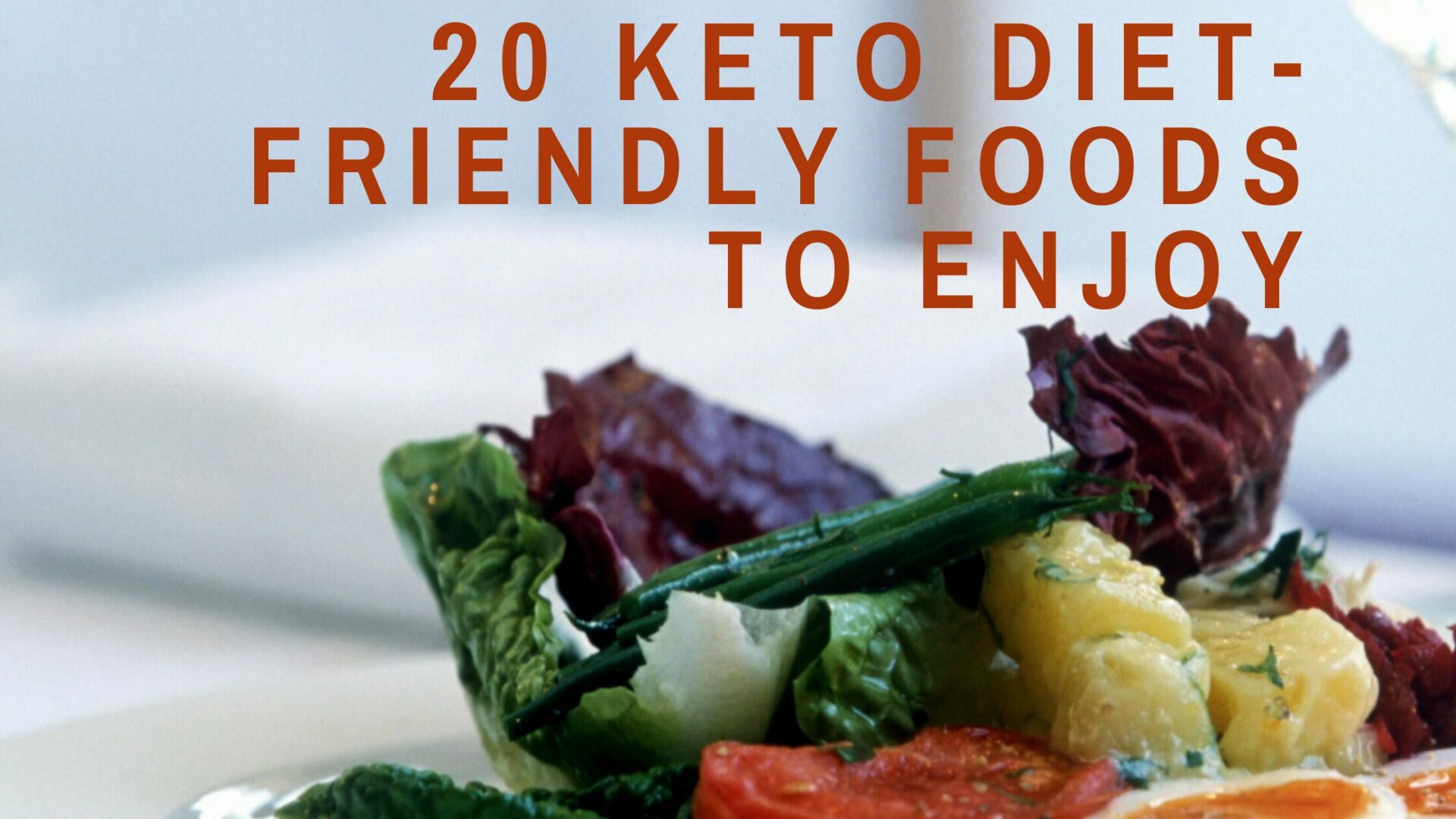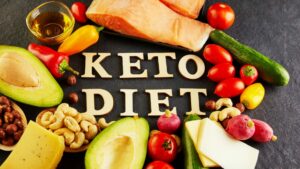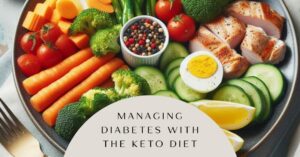The cornerstone of a Keto diet is consuming high-fat, low-carb foods. Followers of this diet typically include a variety of animal proteins, dairy products, vegetables, other plant-based foods, as well as fats and oils in their meals.
The rising popularity of the ketogenic diet can be attributed to its potential advantages in weight loss and blood sugar management.
Preliminary findings indicate that adopting a low carb, high fat diet may offer potential benefits in treating specific cancers, Alzheimer’s disease, and other health ailments. However, further high-quality research is necessary to fully ascertain the long-term safety and efficacy of the keto diet.
The standard keto diet generally restricts carbohydrate intake to 20–50 grams per day.
While some individuals on the keto diet monitor their total carb intake, others track net carbs. Net carbs represent total carbs minus fiber. This distinction is made because fiber is indigestible, thus it cannot be broken down and absorbed by the body.
While the ketogenic diet may appear daunting, it offers individuals the opportunity to consume a wide variety of nutritious foods.

Here are 20 Nutritious Foods for a Keto Diet.
Table of Contents
Animal proteins
1. Meat and Poultry Choices on a Keto Diet
Meat and poultry are fundamental components of the keto diet.
Fresh meat and poultry are carbohydrate-free and boast ample B vitamins and essential minerals. They serve as excellent sources of high-quality protein, aiding in the preservation of muscle mass while following a very low carb diet.
A small-scale study involving older women discovered that a diet rich in fatty meats resulted in an 8% increase in HDL (good) cholesterol levels compared to a low-fat, high-carb diet.
Opting for grass-fed meat, when available, is advisable as it typically contains higher levels of omega-3 fats and conjugated linoleic acid (CLA) compared to meat sourced from grain-fed animals.
2. Eggs on a Keto Diet
Eggs are an exceptionally nutritious and protein-rich food source.
Since each large egg typically contains less than 1 gram of carbs and approximately 6 grams of protein, eggs are considered an excellent choice for a keto diet.
Moreover, studies have demonstrated that eggs can stimulate the release of hormones that promote a sensation of fullness.
Opt for whole eggs over egg whites, as the majority of nutrients reside in the yolk. This includes essential antioxidants like lutein and zeaxanthin, which play a crucial role in maintaining eye health.
Despite being high in cholesterol, egg yolks do not seem to elevate the risk of heart disease.
3. Seafood Choices on a Keto Diet
Fish and shellfish are excellent choices for a keto diet. Salmon and other types of fish are not only low in carbs but also packed with essential nutrients like B vitamins, potassium, and selenium.
Nevertheless, the carbohydrate content in shellfish differs depending on the type. Shrimp and most crabs have negligible carbs, whereas oysters and octopus do contain some. While these foods can still be enjoyed on the keto diet, it’s crucial to monitor their carb intake diligently to ensure it stays within your desired range.
Moreover, salmon, sardines, mackerel, and other fatty fish are rich sources of omega-3 fats. These fats have been linked to reduced insulin levels and improved insulin sensitivity, particularly in individuals who are overweight or obese.
Regular consumption of fish is associated with enhanced brain function and a reduced risk of various diseases.
The American Heart Association suggests that adults aged 18 and above should consume 8–10 ounces of seafood per week.
Dairy and Substitutes on a Keto Diet
4. Unsweetened Plant-Based Milk Options
Numerous types of plant-based milk are suitable for a keto diet, such as soy, almond, and coconut milk.
Opt for unsweetened versions, as sweetened options contain too much sugar to be suitable for a keto diet.
Furthermore, it’s recommended to steer clear of oat milk, as even the unsweetened variety contains too many carbs to align with a keto-friendly diet.
5. Cream and Half-and-Half on a Keto Diet
Cream is derived from the fatty portion of fresh milk, which is separated during milk processing. Conversely, half-and-half is a mixture comprising 50% cream and 50% whole milk.
Both of these dairy products are extremely low in carbohydrates and rich in fats, making them perfect for the ketogenic diet.
Similarly, butter and cream, like other high-fat dairy products, contain conjugated linoleic acid (CLA), which is believed to support fat loss.
Nonetheless, it’s advisable to consume cream and half-and-half in moderation.
The 2021 dietary guidance from the American Heart Association advises individuals to restrict their intake of foods high in saturated fat. Substituting animal and dairy fats with plant-based sources of fat or polyunsaturated fats has been associated with a reduced risk of cardiovascular disease and stroke.
There is conflicting evidence regarding the association between high-fat dairy products and heart disease. While some studies indicate that high-fat dairy may not be strongly linked to heart disease, others suggest that moderate consumption could potentially lower the risk of heart attack and stroke. However, the overall evidence is inconclusive.
This remains a topic of ongoing debate and can vary based on numerous factors, including the extent of food processing.
Cream and half-and-half are commonly used to enhance coffee or substitute small quantities of milk in cooking, making them popular options for those following a keto diet.
6. Plain Greek Yogurt and Cottage Cheese
Plain Greek yogurt and cottage cheese are both nutritious and high in protein. Although they do contain some carbs, you can still enjoy them in moderation while following a keto diet.
Both yogurt and cottage cheese have demonstrated the ability to reduce appetite and increase feelings of satiety.
Both options are delicious snacks by themselves, but you can enhance their flavor by adding chopped nuts, cinnamon, or other spices to create a speedy keto-friendly treat.
7. List of Keto-Friendly Cheeses
- Cheddar
- Cream cheese
- Manchego
- Brie
- Parmesan
- Camembert
- Provolone
- Feta
- Pepper jack
- Blue cheese
- Mascarpone
- Swiss cheese
- Colby jack
- Havarti
- Cottage cheese
- Romano
- Goat cheese
- Limburger
- String cheese
- Muenster
- Chevre
- Mozerella
- Halloumi
Vegetables in Keto Diet
8. Vegetables Rich in Healthy Fats
Avocados and olives, though technically classified as fruits, stand out among vegetables due to their relatively high fat content. Additionally, they are rich in fiber and have a low net carb count.
Oleuropein, the primary antioxidant found in olives, possesses anti-inflammatory properties and has the potential to shield your cells from damage.
Furthermore, a study revealed that individuals who consumed one avocado daily saw enhancements in heart health indicators, such as decreased levels of LDL (bad) cholesterol.
9. Summer Squash in a Keto Diet
Summer squashes like yellow squash and zucchini are highly adaptable and have a low carb content.
Indeed, zucchini is highly favored in keto circles. With a spiralizer, you can create zucchini noodles, a superb alternative to traditional pasta or noodles.
You can use grated zucchini as a rice substitute or incorporate it into baked goods without altering the taste. Additionally, thinly slice it with a mandoline and toss it with olive oil, salt, and pepper for a refreshing cold salad.
10. Peppers in a Keto Diet
Numerous types of peppers are suitable for the keto diet. Despite being classified as fruits, they are commonly used as vegetables in cooking.
Spice up your recipes with small hot peppers, with jalapeños being perfect for creating keto-friendly appetizers. Larger, milder peppers like bell peppers and poblanos can be incorporated into various dishes or stuffed to create delicious low-carb main courses.
Peppers are abundant in vitamin C, with a single bell pepper offering 107% of the daily value (DV) for this essential nutrient.
11. Green Leafy Vegetables to Include in Your Keto Diet
Green leafy vegetables are exceptionally low in carbohydrates, making them ideal choices for a keto diet. Additionally, they are abundant in vitamins, minerals, and antioxidants, enhancing overall nutritional value.
Specifically, nutrient-rich dark leafy greens such as spinach, kale, and collard greens are abundant sources of vitamin K and iron.
Incorporating greens into your meals can provide volume without significantly raising the carb content. Moreover, herbs like oregano and rosemary enhance flavor without adding many carbs.
Here are some Keto Diet -Compatible Leafy Greens:
- Cooking greens: kale, spinach, bok choy, collard greens, mustard greens, Swiss chard, and cabbage
- Salad greens: lettuce, baby spinach, arugula, escarole, and frisée
- Herbs: basil, cilantro, dill, lemongrass, mint, oregano, parsley, rosemary, sage, and thyme
12. Other Non-Starchy Vegetables to Enjoy on a Keto Diet
Numerous additional non-starchy vegetables offer a low-calorie, low-carb option packed with essential nutrients and antioxidants.
Furthermore, low-carb vegetables serve as excellent replacements for high-carb foods.
For example, you can transform low carb cauliflower into cauliflower rice or mashed cauliflower effortlessly. Spaghetti squash provides a natural alternative to traditional spaghetti, while low carb root vegetables like jicama and turnips serve as excellent substitutes for roasted potatoes or french fries.
Here are additional examples of keto-friendly vegetables.
List of Keto-Friendly Vegetables:
- cabbage
- green beans
- tomatoes
- cauliflower
- cucumber
- radishes
- eggplant
- Brussels sprouts
- mushrooms
- celery
- spaghetti squash
- jicama
- turnips
- asparagus
- okra
- broccoli
Other Plant-Based Options on a Keto Diet
13. Dark Chocolate and Cocoa Powder on a Keto Diet
Dark chocolate and cocoa are tasty options rich in antioxidants.
Dark chocolate is rich in flavanols, compounds that could potentially lower blood pressure and promote heart health by maintaining healthy arteries, thus reducing the risk of heart disease.
Interestingly, chocolate can be incorporated into a keto diet. Opt for dark chocolate with at least 70% cocoa solids — ideally higher — and consume it in moderation.
14. Shirataki Noodles: A Keto-Friendly Alternative
Shirataki noodles make an excellent addition to the keto diet. With less than 1 gram of net carbs and only 15 calories per serving, they’re primarily water-based.
These noodles are crafted from a soluble fiber known as glucomannan, providing numerous potential health advantages.
Viscous fiber creates a gel-like substance that delays the passage of food through your digestive system. This can reduce feelings of hunger and prevent rapid spikes in blood sugar levels, potentially assisting with weight loss and managing diabetes.
Shirataki noodles are available in various shapes, such as rice, fettuccine, and linguine. They can be substituted for traditional noodles in nearly any recipe.
15. Berries on a Keto Diet
While many fruits contain excessive carbs for a keto diet, berries are an exception.
Berries, especially raspberries and strawberries, are low in carbs and rich in fiber. Although blackberries and blueberries have fewer carbs compared to some other fruits, they may not align with strict keto diets.
These small fruits are packed with antioxidants that can potentially reduce inflammation and offer protection against various diseases.
16. Nuts and Seeds on a Keto Diet
Nuts and seeds are nutritious, rich in fats, and low in carbohydrates.
Regular consumption of nuts is associated with a decreased risk of heart disease, specific cancers, depression, and various other chronic ailments.
Moreover, nuts and seeds are rich in fiber, promoting satiety and naturally reducing calorie consumption.
While many nuts and seeds boast low net carb counts, the precise amount varies significantly by variety. The types lowest in carbs, and consequently most suitable for keto, include:
- chia seeds
- walnuts
- pecans
- almonds
- macadamia nuts
- flaxseeds
Fats and Oils to Embrace on a Keto Diet
17. Butter and Ghee in a Keto Diet
Butter and ghee are excellent fats to incorporate into your keto diet. Butter contains negligible amounts of carbs, while ghee is entirely carb-free.
Ghee is a type of clarified butter created by heating butter and skimming off the milk solids that float to the surface. It possesses a rich, concentrated buttery flavor and is frequently employed in Indian cuisine.
Similar to other full-fat dairy products, butter and ghee seem to have less detrimental effects on health than previously believed.
18. Olive Oil in a Keto Diet
Olive oil offers remarkable benefits for heart health.
It contains high levels of oleic acid, a monounsaturated fat known to reduce risk factors associated with heart disease.
Furthermore, extra-virgin olive oil is rich in polyphenol antioxidants, which are plant compounds that contribute to heart health by reducing inflammation and enhancing artery function.
As a pure source of fat, olive oil contains zero carbs. It serves as an excellent foundation for crafting salad dressings and nutritious mayonnaise options.
Due to its lower stability at high temperatures compared to saturated fats, it’s advisable to utilize olive oil for low-heat cooking or incorporate it into dishes after they have been cooked.
Other fantastic plant-based oils to consider on a keto diet include coconut oil and avocado oil.
Beverages
19. Unsweetened sparkling water in a Keto Diet
If you’re seeking a soda substitute that fits your keto lifestyle, opt for unsweetened sparkling water as an excellent option.
These drinks are delightfully effervescent and often come in various flavors, yet they typically contain no sugar or sweeteners. As a result, they boast zero calories and carbs.
Nonetheless, it’s important to note that some varieties may be naturally flavored with small amounts of fruit juice, potentially containing carbs. Always check the label, as additional carbs can accumulate rapidly.
20. Unsweetened coffee and tea in a Keto Diet
Coffee and tea are beneficial beverages that contain no carbohydrates.
They are rich in caffeine, which can boost your metabolic rate and potentially enhance your physical capabilities, attentiveness, and emotional state.
Additionally, it has been observed that individuals who consume coffee and tea regularly have a notably lower risk of developing diabetes. Interestingly, the risk appears to be the lowest among those who consume coffee the most, although a definitive cause and effect relationship has not been established yet.
Incorporating heavy cream into your coffee or tea is acceptable, but you should steer clear of ‘light’ coffee and tea lattes when following a keto diet, as they are usually prepared with nonfat milk and flavorings high in carbohydrates.
Conclusions
The ketogenic diet can aid in shedding pounds, managing blood sugar levels, and achieving various health objectives. However, its high-fat, low-carb methodology might appear excessively limiting, particularly in the beginning.
Despite this, this dietary regimen includes a broad array of wholesome, delicious, and adaptable foods that allow you to maintain your daily carbohydrate intake.
To maximize the health advantages of the ketogenic diet, it’s recommended to consume a diverse range of these foods.





